Subtotal: $
Checkout
Saint Patrick’s Windows into Grief
On a tiny island in a lake in Ireland, Harry Clarke’s stations of the cross in stained glass comforted me as I grieved my mother.
By Lanta Davis
March 17, 2024
When I hopped on the boat that chilly, foggy day to visit Station Island, I had my doubts about its legends. I’d heard about the Irish island’s connection with Saint Patrick, but surely its stories of caves and monsters and purgatory couldn’t be true.
The island, however, proved me wrong. I’d expected to go and learn a little about its history, walk around the island, and gaze at the church’s splendid stained-glass windows. But when I crossed the boat back to the mainland, I discovered I’d gone on an accidental pilgrimage. Just as the legend predicted, I’d been granted a vision and faced my monsters. My purgatory wasn’t a place so much as a state of being, and the monsters battering me were not storybook beasts with fantastical horns, feathers, or sharp teeth, but rather common creatures, known by the names of grief, doubt, and despair.
Station Island may be little-known today outside of Ireland, but it was world-famous in the Middle Ages. Nicknamed Saint Patrick’s Purgatory, the tiny island on Lough Derg became famous as a portal to purgatory. Legend says that Saint Patrick visited the island to pray for something to help the stubborn Irish pagans convert. On Station Island, he found it. After descending into a cave, he experienced the pains and perils of purgatory, “proof” of the eternal beyond. Pilgrims followed Saint Patrick’s example. Fasting and praying, they visited the island, locked themselves into the cave, and emerged, “reborn,” twenty-four hours later. Stories about what these pilgrims experienced in “purgatory” – and the colorful demons they encountered – were wildly popular. They may have even inspired Dante.
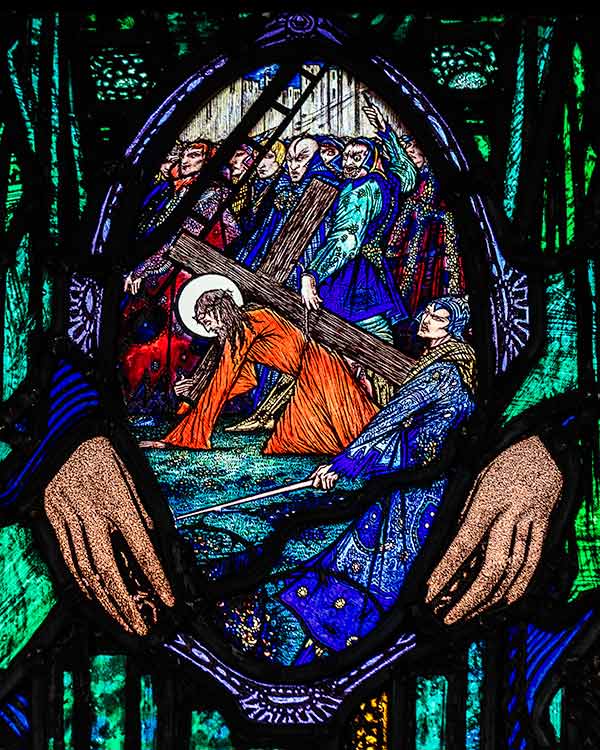
Harry Clarke, Jesus falls for the first time. The stained glass windows were created and installed at the Basilica of Saint Patrick's Purgatory, Pettigo, Lough Derg, 1927–1929. All photographs by James Edwards. 2017. Used by permission.
Designed by Harry Clarke, an Irish stained-glass artist, the windows feature the apostles and the stations of the cross. Seemingly floating in the windows amid geometric bursts of color, the apostles almost feel ethereal. Each apostle clasps a mirror-like oval medallion that features the fourteen stages of the via dolorosa. Their faces still and serene, their hands hold a dramatic movement toward death.
My husband and I had fallen in love with Harry Clarke’s work on our first trip to Dublin, where we spent almost an hour standing in front of his Mother of Sorrows. Clarke’s gothic, fairy-tale style and rich, saturated colors captivated us. His large-eyed figures seemed to peer back at us, and we couldn’t look away.
We obsessively researched more about Clarke and made a list of where we could see more of his works. He has windows across all of Ireland, in churches, museums, and schools. But at the top of our wish list were the fourteen windows on Station Island. Nowhere else offered such a large set of Clarke’s windows in one place.
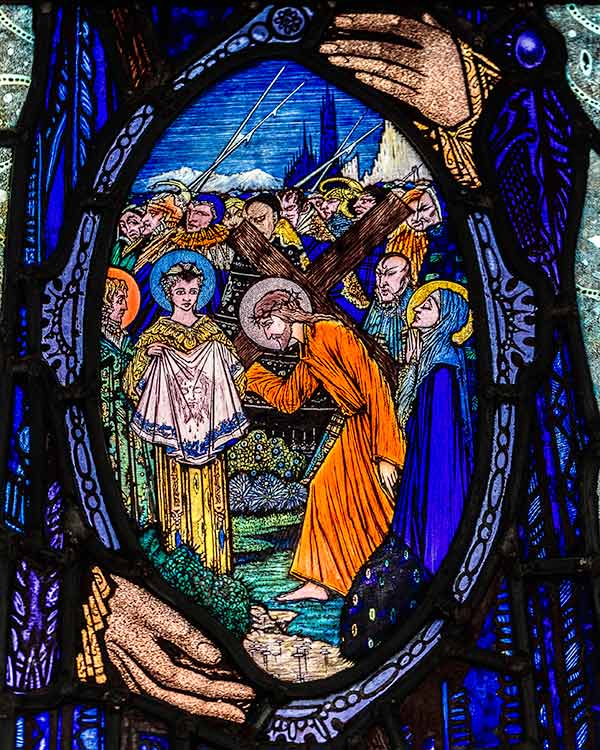
Harry Clarke, Veronica wipes the face of Jesus.
Before we could visit the island, tragedy struck. In the middle of my six-month teaching appointment in Northern Ireland, my mother died from a sudden heart attack. It was my fall break, and my husband and I had planned a quick trip to Amsterdam. We had just landed when my father called to tell me the news. Processing the reality of losing my mother while walking past sex workers and marijuana shops was surreal. We flew to South Dakota the next morning, and I discovered it was even harder to confront my new reality back home.
After the funeral, I didn’t really know what to do with myself. My mother had been very much the hub of our family, and without her our lives were thrown into chaos. I felt flooded with questions. I could accept that my whys would generally go unanswered. The whats and hows, on the other hand, were more immediate and practical. How would my newly widowed father, who had never used the dishwasher or the washing machine, fare on his own, especially when none of his children live nearby? What will he eat? How will he handle farming without my mom’s near-constant help? Who will help him manage his bookwork, his appointments, the daily tasks of life?
And how would my brother, who was very recently recovering from alcohol addiction, handle this blow? When he first decided to seek treatment, I overwhelmed him with instructions and anxiety. It was my mother who helped him figure out a plan, who helped him establish a sense of ownership over his recovery. Now that she was gone, who would fill that role?
I quickly discovered that learning someone you love has died is but the first death; a million more follow as we bump up against the sudden hole in our lives. It was the big questions, but also the small moments. It was also discovering a mini peach pie in the freezer and knowing it was the last pie my mom would ever make. It was packing up for a trip without anyone fussing over me and trying to hand me baked goods for the journey. It was seeing her recently renewed passport, which she had been planning to use in two more weeks to visit me.
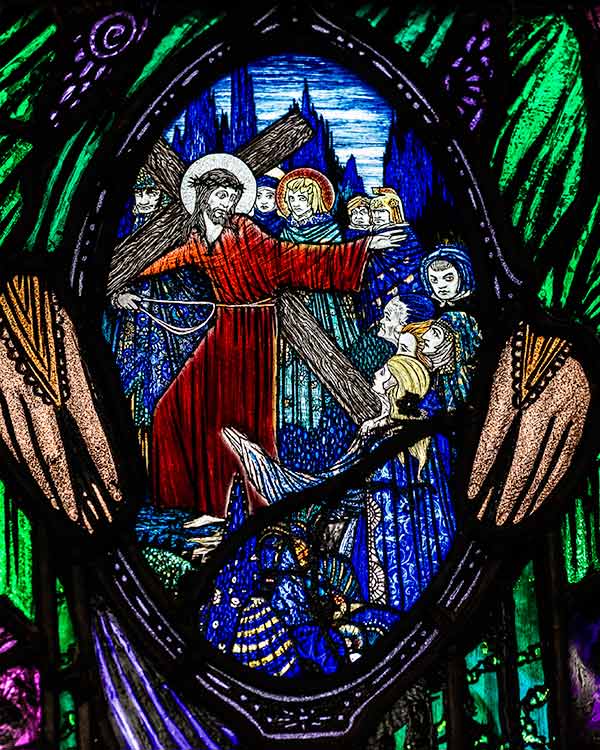
Harry Clarke, The women of Jerusalem weep for Jesus.
When my dad came alone on the trip my mom had planned for them both, watching him try to figure out how to travel alone (which began with him trying to pack for a two-week, international trip in a shopping bag and accidentally deleting three of my attempts to send him his boarding pass over email), seeing him sleeping in a single bed, and hearing him self-correct “my wife is” to “my wife was” added further tallies to the death count, piercing fresh wounds into my already battered and raw heart.
So when we made the trek to Lough Derg together just a few weeks after my mother’s death, I was caught in my own personal purgatory, swimming in the anxiety and confusion of the in-between and uncertain.
As my dad, my husband, and I walked around Station Island and learned more about its history from the prior of the church, I was astonished by all this small island had seen: missionaries and monks; knights and Vikings; saints and sinners.
But in the end, the trip was still all about the windows for me.
Clarke’s stained-glass stations of the cross look like a fairy tale, but here, there are no princesses, monsters, or enchanted forests. Instead, they depict the most magical story of all: redemption.
The oval medallion each apostle holds feels like a Christian version of a “magic mirror.” The apostles invite you to peer into the window, their hands drawing your attention to the unfolding action of the via dolorosa. In almost every station, someone in the scene looks directly at you, staring into your eyes and letting you know you are seen, that you are part of the event. Look, they say. We are part of this story – and so are you.
In Clarke’s first station, Pilate washes his hands in the background while Jesus stands, condemned, his hands open but chained. The decision is done, death declared. The window, and its mix of guilty and innocent hands, poses the question of blame. Who is responsible for Jesus’ death? Pilate’s washing of his hands makes us examine our own guilty and bloodstained hands. But Jesus offers his own innocent hands, and his own blood, so that they may be washed clean.
By inviting us to walk with Jesus in his suffering, the stations of the cross remind us that Jesus walks with us in ours.
Jesus’ willingness to offer himself is reinforced in the tenth station of the cross. Jesus stands, staring at the viewer as he’s stripped of his robe, vulnerable and exposed. “Here,” his expression seems to say, “is my body, about to be broken for you.” A skull peers at us from below his feet. Jesus is on the journey to his death, and the station reminds us that we are, too.
The journey toward death is no light, easy feat, even for the Son of God. When Jesus picks up his cross and begins walking, he struggles to carry it, his back bending under its weight. In traditional stations of the cross, such as Clarke’s windows, Jesus falls not just once, but three times. The repetition can feel redundant when you look at it objectively: do we really need three of the fourteen stations to be Jesus falling? But seeing Jesus falling under the weight of the cross reminds us of the burden he has taken on for us. It also shows us a model of perseverance. Courage is not always a matter of conquering; sometimes it’s just about carrying on.
The road may be lonely, but Jesus is not alone. Simon steps in to assist Jesus in carrying the cross. Veronica offers a cloth for Jesus to wipe his face. Jesus greets his mother and the weeping women of Jerusalem. They cannot take on Jesus’ suffering for him, but they are more than mere spectators. By walking alongside Jesus, they share in his suffering and help lighten his burden.
In most of the windows, Jesus’ bright robe fits with the vibrant colors in the rest of the window. But that changes after Jesus is stripped of his robe and nailed to the cross. In contrast to the colorful figures who surround him, Jesus’ almost grayscale coloring tells us the shadow of death has cast its pallor. He looks drained of life. But instead of fading into the background, he radiates all the more, practically shimmering in the window. As his mortal life drains from his, his divinity shines through.
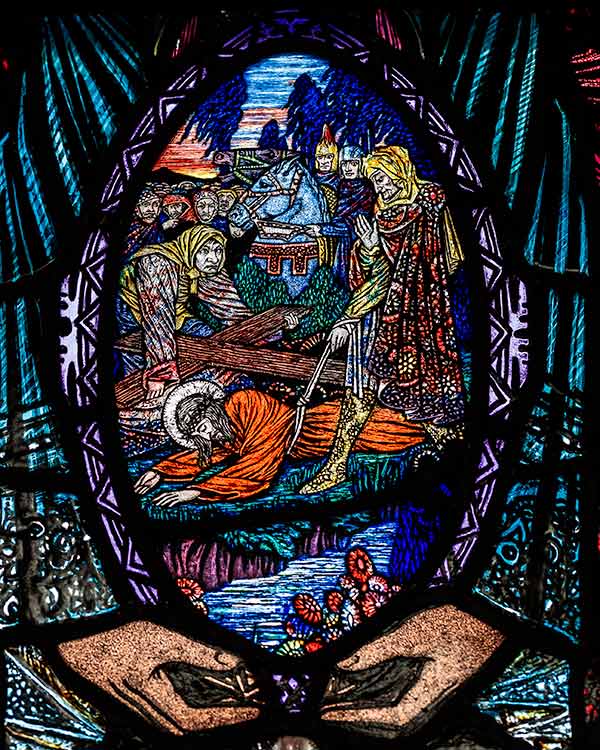
Harry Clarke, Jesus falls for the third time.
At the last station, Jesus’ family and friends place his body in a tomb. For them, it’s the end of the story. We see no resurrection, no obvious hint of hope, no clue about what might happen next. At the end of the road, there is just the finality of death.
Ending with death rather than resurrection seems surprisingly dark, even hopeless. But it felt, that day, like a ray of hope. The pause in the purgatorial in-between of the tomb and the resurrection felt incredibly liberating. Sometimes we are so eager to rush to the resurrection we forget to stop at the tomb. I had grown tired of the words of reassurance I’d heard the past few weeks. Telling me my mother is happy in heaven is an understandable impulse, a reminder that our loved ones are not gone forever. But in the depths of grieving, these kinds of messages can also feel too pat, too easy, too quick. They seem to tell us to hurry on up with our sadness. Amid these kinds of “comforts,” grief can feel like a lack of faith.
But the stations of the cross remind us that the full joy and surprise of a happy ending hinge upon properly pausing in the moment where everything feels most hopeless. Sometimes, we simply have to sit in the uncomfortable, undefined space of uncertainty and transition.
By inviting us to walk with Jesus in his suffering, the stations of the cross remind us that Jesus walks with us in ours. On the via dolorosa, there is space for the purgatorial uncertainty of grief. There is space for questions. There is permission to fall when the weight becomes too heavy. There’s even an invitation to sit in the darkness, next to the tomb, and simply cry for a while.
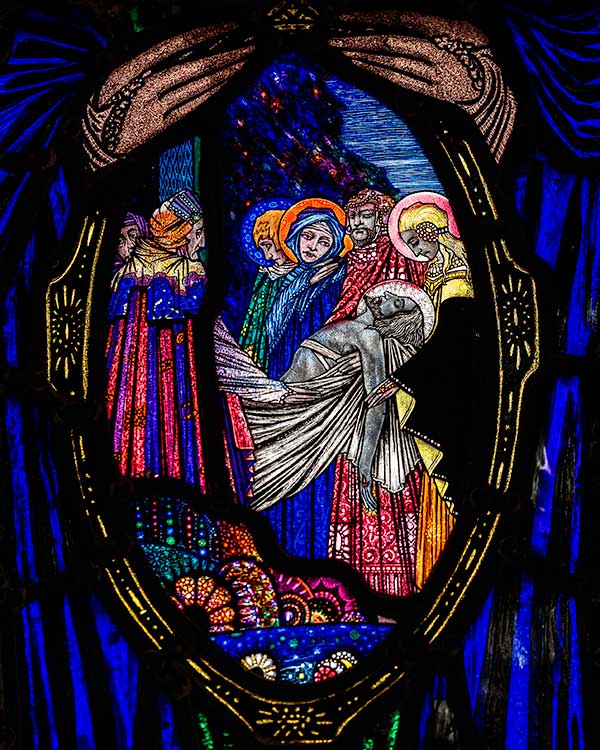
Harry Clarke, The body of Jesus is laid in the tomb.
Rather than offering us false promises of ease and comfort, the stations of the cross direct us to the hard-won hope that comes from walking the way of suffering itself. The apostles hold the stations of the cross in the center of their bodies, as if carrying this suffering in their bellies. The violent drama of the cross unfolds, yet the disciples seem serenely calm. Clarke’s fairy-tale figures and rich colors combined with the apostles’ contemplative expressions seem to suggest that accepting suffering is simply part of the story, that we carry our crosses to affirm the vivid surprise and colorful beauty of life.
This message is especially clear in the final station, where Mary, “Queen of the Apostles,” holds the image of Jesus’ death over the womb. When she said “yes” to bearing Jesus, she also said “yes” to losing to him. Grief and gratitude are an odd pairing, but inextricably intertwined. Bearing the pain of losing my mom was a condition of the gift of loving her, a gift that brought color and joy and love to my life.
When I got back on the boat that day, I realized that as skeptical as I’d been about the island’s stories, I was leaving with my own. Did that mean I’d solved all my problems and answered all my questions? No, of course not. Clarke’s windows may look like a magic mirror, but they weren’t a portal to my happy ending, nor did they show me how to escape from my sorrows. They did, however, show me the way through them. The via dolorosa had pointed me to the path of hopeful endurance, the road of grief and gratitude.
As the boat gained distance from the island, so did my perspective about Saint Patrick’s story. Read historically, I admit I still have my doubts about Saint Patrick’s Purgatory. Then again, maybe this fantastical story could be read as a story, with its monsters and purgatory understood as a vivid way to describe an exhausted man in the middle of a crisis. Uncertain about his mission, he visits Station Island to pause, face his doubts and despair, and find a way forward. Read this way, Patrick’s purgatory is less about a literal place as it is a time of transition and searching. Read this way, perhaps Patrick, too, left the island like I did: a little more ready to walk the way of the cross.
Already a subscriber? Sign in
Try 3 months of unlimited access. Start your FREE TRIAL today. Cancel anytime.







Lindsay¹ Lowry
Wonderful comment